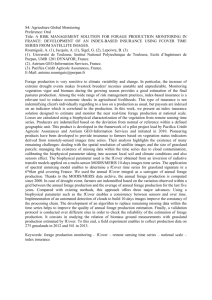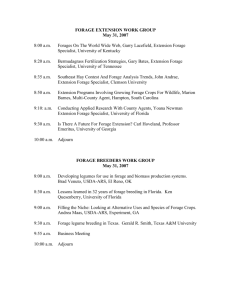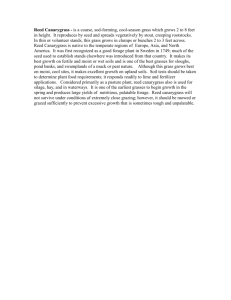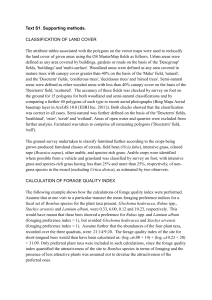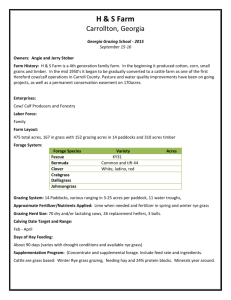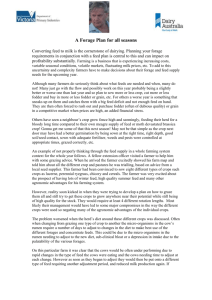grassland improvement and fodder production in farming systems of
advertisement
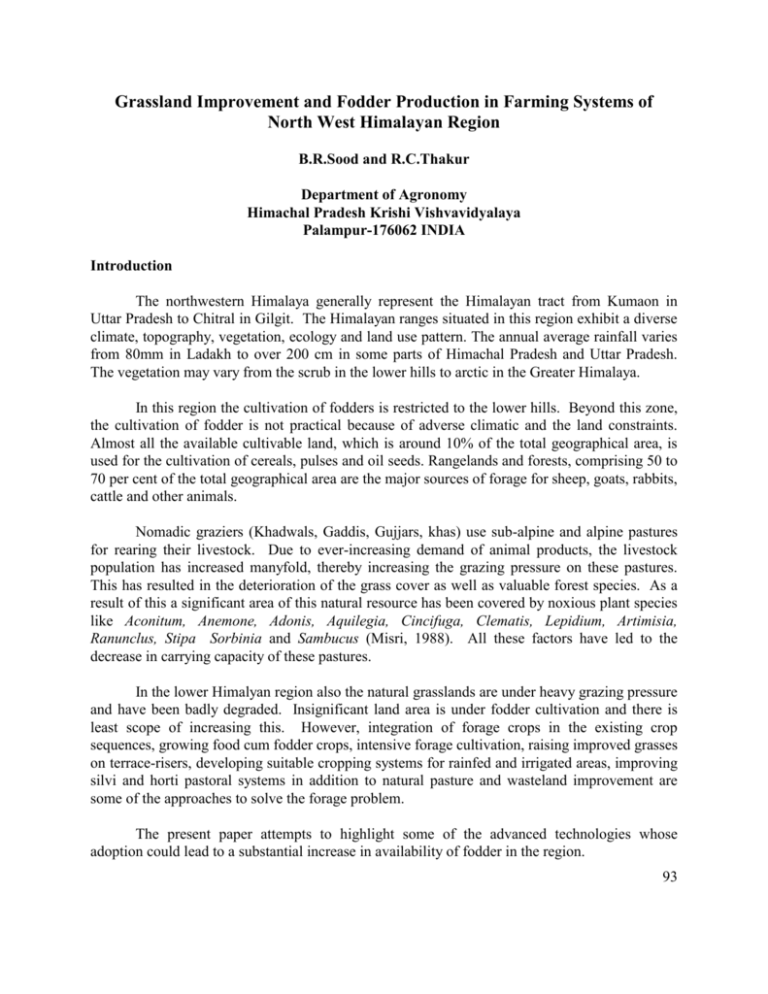
Grassland Improvement and Fodder Production in Farming Systems of North West Himalayan Region B.R.Sood and R.C.Thakur Department of Agronomy Himachal Pradesh Krishi Vishvavidyalaya Palampur-176062 INDIA Introduction The northwestern Himalaya generally represent the Himalayan tract from Kumaon in Uttar Pradesh to Chitral in Gilgit. The Himalayan ranges situated in this region exhibit a diverse climate, topography, vegetation, ecology and land use pattern. The annual average rainfall varies from 80mm in Ladakh to over 200 cm in some parts of Himachal Pradesh and Uttar Pradesh. The vegetation may vary from the scrub in the lower hills to arctic in the Greater Himalaya. In this region the cultivation of fodders is restricted to the lower hills. Beyond this zone, the cultivation of fodder is not practical because of adverse climatic and the land constraints. Almost all the available cultivable land, which is around 10% of the total geographical area, is used for the cultivation of cereals, pulses and oil seeds. Rangelands and forests, comprising 50 to 70 per cent of the total geographical area are the major sources of forage for sheep, goats, rabbits, cattle and other animals. Nomadic graziers (Khadwals, Gaddis, Gujjars, khas) use sub-alpine and alpine pastures for rearing their livestock. Due to ever-increasing demand of animal products, the livestock population has increased manyfold, thereby increasing the grazing pressure on these pastures. This has resulted in the deterioration of the grass cover as well as valuable forest species. As a result of this a significant area of this natural resource has been covered by noxious plant species like Aconitum, Anemone, Adonis, Aquilegia, Cincifuga, Clematis, Lepidium, Artimisia, Ranunclus, Stipa Sorbinia and Sambucus (Misri, 1988). All these factors have led to the decrease in carrying capacity of these pastures. In the lower Himalyan region also the natural grasslands are under heavy grazing pressure and have been badly degraded. Insignificant land area is under fodder cultivation and there is least scope of increasing this. However, integration of forage crops in the existing crop sequences, growing food cum fodder crops, intensive forage cultivation, raising improved grasses on terrace-risers, developing suitable cropping systems for rainfed and irrigated areas, improving silvi and horti pastoral systems in addition to natural pasture and wasteland improvement are some of the approaches to solve the forage problem. The present paper attempts to highlight some of the advanced technologies whose adoption could lead to a substantial increase in availability of fodder in the region. 93 Improvement of Natural grasslands Effect of fertilization None of the natural grasslands in sub -temperate, temperate and sub-alpine regions are fertilized in any form except dung and urine addition by the grazing animals. This leads to continuous depletion of plant nutrients resulting in the poor growth of plant-species. Experiments have revealed that there is a significant impact on the herbage productivity and quality of natural grasslands following proper fertilization (Table 1 and 2). Table 1. Effect of N and P application on the productivity of a natural grassland. Treatments 0 N-levels 0 30 60 90 Mean 6.1 9.9 12.8 13.2 10.5 CD 5% Forage yield (t/ha) P2O5 (kg/ha) 30 60 7.9 18.6 20.7 21.1 16.9 Nitrogen Phosphorus NxP Mean 9.5 19.1 20.6 21.3 17.6 7.8 15.9 18.0 18.5 1.1 1.3 0.7 Source: Sood and Sharma, 1996 Table 2. Effect of dose and time of nitrogen application on the productivity of a grassland Treatments N-dose 0 40 80 C.D. 5% Time of N-application Basal Two splits C.D. 5% Source : Singh, 1995 Fresh Forage yield (t/ha) 10.4 15.2 19.6 0.3 14.7 20.2 0.5 94 Herbage yield increased significantly with the application of nitrogen and phosphorus, 60 kg N and 30 kg P2O5/ha was found the best dose of fertilizer (Table-1). Nitrogen @ 40 and 80 kg ha-1 was applied as basal and two splits (onset of monsoon and 45 days after first dose) in the natural grassland. Forage yield increased significantly with the increase in nitrogen to the level of 80 kg. Two splits were significantly superior to single application (Table 2). For getting higher forage yield and better quality of sown pastures, the improved grass species need to be fertilized with adequate amount of nitrogen and phosphorus. The experiment conducted on N x P requirement reveal that application of 80 kg/ha each of nitrogen and phosphorus was found to be the best dose of fertilizer. The increase in fresh forage yield over control was 152.4 and 42.9 per cent, respectively. Crude protein content also showed significant increase with the application of fertilizer (Table 3). Table 3. Effect of N and P levels on herbage yield and C.P. content of Setaria CV. Narok. Treatment N kg/ha 0 40 80 120 P2O5 kg/ha 0 40 80 Forage yield (t/ha) Fresh Dry C.P. (%) 12.2 22.4 30.8 31.0 3.6 6.1 8.8 8.9 8.7 9.8 10.2 10.9 19.1 25.9 27.3 5.4 7.3 7.9 9.6 9.9 10.2 Source: Sood and Bhandari, 1992. Effect of grass/legume introduction Introduction of improved grass/legume species in the native vegetation not only helps in increasing total biomass production but also improve the quantity of the produce. However, the introduction of improved species in the existing vegetation particularly with seed is not an easy task, unless initial competition from the native vegetation is checked by some means. In view of sloppy terrain in hill soil work may lead to soil and nutrients losses. However, the sod killing herbicides like paraquat has shown good results. (Table 4) 95 Table 4. Impact of Siratro introduction on the productivity of a natural grassland. Treatment Method of introduction M1 After paraquat spray (whole plot) M2 After burning M3 Without removal of existing vegetation M4 After paraquat spray in 15 cm bands M5 No introduction Source: Sood and Singh, 1986 Forage yield (t/ha) Fresh Dry 16.4 7.2 15.3 14.1 6.6 6.0 17.7 7.8 12.4 5.4 Introduction of Siratro after paraquat spray in 15-cm bands @ 0.6 L/ha was found to be the best method of introduction of Siratro in the existing vegetation. It increased fresh forage yield by 26.8% over no introduction (Table 4). Table 5. Effect of introduction techniques on the forage yield of Guinea and Setaria grass under natural grassland. Treatment Grass species 1. Guinea (PGG-19) 2. Guinea (PGG-9) 3. Setaria (PSS-1) 4. Local spp. Introduction techniques 1. After scraping existing vegetation 15 cm band 2. After paraquat spray in 15 cm band 3. In pits (15 cm dia) Source : Sood and Kumar, 1996 Forage yield (t/ha) Fresh Dry 21.1 25.5 38.7 12.9 4.9 5.8 8.5 3.5 25.4 5.8 29.7 32.1 6.7 6.8 Introduction of Setaria (PSS-1) resulted in 51.8 and 216.8 per cent higher fresh forage yield over Guinea (PGG-9) and control (no introduction), respectively. Introduction in pits 15cm dia at a distance of 40-x 40-cm was found the best technique closely followed by paraquat killing in 15 cm bands (Table 5). The suitable grass and legume species identified for the introduction in natural grasslands in different agroclimatic zones of Himachal Pradesh is given in (Table 6). 96 Table 6. Grass and legume species for different Agroclimatic zones Zone Sub-tropical 300-1800 m Species Grass Temperate 1800-3200 m Legume a. Humid Grass Legume b. Dry Alpine zone (above 3200 m) Source: Katoch ET al., 1992 Setaria anceps, Panicum maximum, Napier bajra hybrids, Pennisetum orientale Siratro, Desmodium Dactylis glomerata, Bromus spp., Phleum pratense Trifolium repens, Trifolium pratense Agropyron spp. Medicago spp. Poa bulbosum, Agrostis stolonifera and Onobrychis vicifolia Cutting and grazing Generally, uncontrolled and continuous grazing is prevalent in most of the grasslands throughout the northwestern Himalayas. Though rotational system of grazing gives better results but it is not so easy to adopt it on large scale in hilly situations. The most desirable system of grazing would be that of periodic or deferred grazing by limiting the number of livestock on the basis of carrying capacity of grasslands. This system would give a better chance for self-seeding and stand recovery. However, it has been found that cut and carry system provides higher production of biomass (Table 7.) Table 7. Effect of cutting and grazing management on composition and forage yield of grasslands. Management System Continuous grazing Harvested at 4-week interval Harvested two time July 30 and Oct. 30 C.D. 5% Source: Singh, 1995 Composition Imperata sp. Digitaria, Cynodon, Echinochloa, carex Hetropogon, Cynodon, Imperata, Carex, Chrysopogon Hetropogon, Chrysopogon, Themeda, Arundinella, Atylosia, Trifolium Yield (t/ha) 5.3 9.18 12.2 3.4 Hortipastoral System There is considerable area under orchards in temperate regions. Inter spaces between fruit trees could be utilized for the production of fodder by growing perennial grasses and 97 legumes depending upon the topography, age of the trees and spacing etc. The cultivation of legumes would be more desirable because of their nitrogen fixing ability. Table 8 Fodder production under hortipasture system Species Seed rate kg/ha Dactylis + Red clover Ryegrass + Red clover Brome grass+ Red clover Timothy + Sub-clover Source: Misri, 1998 5 4 5 4 15 4 4 50 Fertilizer (kg/ha) 90 N 60 P2O5 120 N 90 P2O5 90 N 60 P2O5 90 N 60 P2O5 Green forage yield (t/ha) 42.0 48.0 39.0 35.0 Various combinations of grasses and legumes were tried in an apple orchard. The seeds of grasses and legumes were sown in alternate rows, 30 cm apart. All the species excepting subclover were perennial and with minimum inputs providing fodder for a longer period (Table 8). In Shimla district of Himachal Pradesh, plantation of Fescue grass in apple orchard gave 6.7-t green fodder yield compared to 1.1 t/ha from local grasses. Similarly in U.P. hills, Singh, (1995) reported that rye and orchard grass were found to be the best grass species and red and white clovers and Lucerne the best perennial legume for introduction in apple orchards. Soil N build up was maximum with white clover introduction. Fodder tree plantation The integrated approach of growing grasses and fodder crops under silvipasture and agroforestry systems is one of the major alternatives to augment fodder and fuel wood production. The experiments conducted at VPKAS Almora revealed that Digitaria decumbans; Pennisetum clandestinum and Chloris gayana were the promising grass species, which can be grown successfully under pine and deodar plantations. The performance of local grass species was the poorest (Table 9). In another experiment under improved silvipastoral system in sub-temperate region of H.P., it was found that introduction of Setaria + Siratro in-between the two double hedge rows (50 x 50 cm) of Robinia, spaced 10 m apart recorded 2.74 times higher carrying capacity over control (Table 10). 98 Table 9. Yield performance of improved and local grass species under Pine and Deodar trees Grass species Pangola Rhodes Para Guinea Kikyu Local Source: Koranne and Singh, 1989 Forage yield (t/ha) Pine trees Deodar trees 14.01 13.66 4.78 3.06 0.48 2.06 0.41 2.04 6.42 0.25 0.22 Table 10. Dry matter production and carrying capacity of improved grassland and a silvipastoral system. Treatment Dry matter (t/ha) Control Control+Setaria Control+Setaria+Siratro Control+Setaria+Siratro +Leucaena Control+Setaria+Siratro +Robinia Source: Anonymous, 1995. 6.9 15.1(2.2+12.9) 15.5(2.1+12.9+0.5) 17.1(2.3+14.2+0.4+0.2) 18.4(2.4+14.5+0.6+0.9) Carrying capacity Au/ha/annum 2.7 6.6 6.1 7.2 7.4 Fodder Production in Farming Systems Every household in the hills rear different kinds of animals for various purposes but for maintaining the milch animals it is essential to put some part of the cultivable land under forage crops. Following approaches are being proposed in view of their wider acceptability by the farming communities. Forage Production on Terrace Riser/Bunds A non-competitive land use system for the forage production in the hills is to grow improved grasses on terrace bunds and risers. There is added advantage to produce forge without any fertilizer or manure since it is available from the cropped terrace. The field experiments conducted in U.P. hills reveal that growing grasses on terrace riser was found significantly beneficial for increasing the grain yield of rice and wheat over control. The performance of different improved grass species was statistically similar but superior to local species (Table 11). 99 Table 11. Performance of some grasses on terrace risers and their effect on main crops. Terrace grasses Nandi grass Guinea grass Hybrid Napier Rhode grass Indian couch grass Control C.D. 5% Source: Singh, 1995. Grain yield (t/ha) Rice Wheat 1.04 1.14 1.01 1.16 1.08 1.21 0.98 1.04 0.91 1.02 0.97 0.98 NS NS Forage yield of grasses (t/ha) 10.8 10.4 15.0 9.9 8.6 1.2 0.6 Raising forage crops in food crop sequences The performance of oat + shaftal mixture was assessed in rice based cropping system in mid Himalyan region at two farming situations. At both the farming situations Rice-oat+shaftal performed second best after Rice-Radish-Onion sequence. Its performance over the traditional Rice-Wheat system was far better (Table 12). Table 12. Performance of Oat+Shaftal mixture in rice based cropping system Crop sequence Farming situation- Gross Farming situation-II I (6-Trials) return (6-Trials) (Rs/ha) Yield q/ha Yield q/ha Kharif Rabi Kharif Rabi Rice-Wheat 43.8 58.1 56769 45.2 47.8 Rice-Radish-Onion 44.3-172.5 227.2 116176 44.5-105.9 209.8 Rice-Lentil 43.9 17.64 46621 45.0 13.8 Rice-Oat+Shaftal 44.8 782.6 84993 44.7 728.5 Farming Situation-I (Bajaura) Kullu - Tharash, Kalibehar, Jia Farming Situation-II (Mandi) - Chail Chowk, Pangna, Karsog Source: Anonymous, 1996-97 Gross return (Rs/ha) 51288 101074 419098 80648 Fodder Cropping Systems for rainfed area Oat and barley alongwith pea and mustard have been identified, as the best winter forage while maize is the best summer crop under rainfed farming. However, farmers are generally reluctant to raise maize as a fodder crop for the reason that this being the staple food crop of hills. Therefore, an attempt was made to serve both the purposes of food and fodder simultaneously from this crop. Oat and barley alongwith pea and mustard have been identified as 100 the best winter forages (Table 13) while maize is the best forage crop during summer under rainfed conditions. Maize could be cultivated for both grain and forage (Table 14) Table 13. Winter forage cropping system for rainfed areas. Treatment Forage yield (t/ha) Fresh Dry Fodder crops Oat Barley Oat+Barley Cropping Systems Fodder crops pure Fodder crops+pea Fodder crops+sarson Source: Kumar and Sood, 1993. C.P. Yield (t/ha) 34.7 28.9 29.1 8.0 6.6 5.9 1.01 0.83 0.74 30.8 32.6 31.2 7.2 7.5 7.0 0.69 1.10 0.77 Table 14. Grain fresh fodder and stover yield of maize (Rainfed). Treatment Grain Nitrogen (kg/ha) 90 112.5 135.0 Harvesting stages 60 DAS 75 DAS Standard practices C.D. 5% Source: Anon., 1991 Yield (t/ha) Fresh fodder Stover 3.4 3.9 4.2 18.9 21.2 22.6 8.8 9.5 9.9 3.8 3.2 4.6 0.6 18.9 22.9 1.6 9.4 9.0 9.8 1.5 Intensive Forage Production systems The year round fodder supply is very important in order to stabilize animal production especially in the milk-shed areas and also for small farmers who maintain dairy animals as a regular source of income. Some of the best forage crop rotations standardized for the northwestern Himalayan region are given in Table 16. 101 Table 15. Forage yield and economics of different intensive forage crop rotations (Average over 5 years). Sr. No. 1. Crop rotations Maize+CowpeaBerseem+Oat Green forage yield t/ha 94.2 Dry forage yield t/ha 20.1 Net Returns Rs/ha 18252 2. Teosinte+VelvetbeanOat+pea 79.2 15.3 14754 3. Napier Bajra hybrid+ velvetbeanBerseem+Sarson 129.9 25.3 26995 4. Napier Bajra HybridTurnip-Oat+Vetch 86.1 17.4 15212 5. Setaria intercropped with soybean (kharif) followed by berseem (winter) 83.6 17.8 17778 6. Maize+Velvet beanLucerne+berseem 85.4 15.8 16537 Sorghum+CowpeaBerseem+Sarson Source: Sood and Bhandari, 1987 86.3 17.8 17124 7. Inter Cropped/mixed Cropping Systems Intercropping /mixed cropping systems of forge production has proved advantageous from biomass production and quality point of view. The system also helps in economising the fertilizer use. The studies conducted at Himachal Pradesh Krishi Vishvavidyalaya, Palampur indicated that inter cropping of sorghum with legumes produced 26.5 per cent higher green forage yield over sorghum alone. This system also resulted in higher crude protein content and in-vitro dry matter digestibility (IVDMD) (Table 16). 102 Table 16. Forage yield, crude protein content and in vitro dry matter digestibility. Treatment Forage yield (t/ha) Green Dry Intercropping System Sorghum + Velvetbean 26.8 Sorghum+cowpea 24.5 Sorghum+soybean 25.2 Sorghum alone 20.2 Source: Sood and Sharma, 1992 9.1 8.1 8.4 7.2 C.P. content (%) IVDMD (%) 11.9 12.1 12.3 7.1 55.4 56.5 57.6 49.6 References Anonymous, 1991. Effect of nitrogen levels and harvesting stages on the grain and fodder yield of maize. Annual Prog. Report Dept. of Agronomy, HPKV, Palampur 18:205-06. Anonymous 1997. Annual Report Cropping Systems Research, Department Agronomy, HPKV, Palampur. Koranne, K.D. and J.P. Singh, 1989. Technologies for increasing forage production of grasslands and non-agricultural lands in the hilly region. Paper presented in the workshop on pasture and grasslands improvement at HPKV, Palampur on 12 & 13 Oct. 1989. Kumar, Naveen and B.R.Sood, 1993. Effect of Cropping Systems and sowing methods on the yield and quality of Rabi forages under rainfed conditions. Haryana J. Agron. 9(11): 56-58. Misri, Bimal. 1988. Forage production in alpine and sub-alpine of NorthWest Himalayas. Published in Pasture and Forage Crops Research. Ed. Punjab Singh Page. 43-55. Premi, O.P., B.R. Sood, B.S.Katoch and K.K. Dogra, 1997. Production potential quality and carrying capacity of improved grassland vis-a-vis silvipastoral system. Paper submitted to Range Mgmt. & Agroforestry. Sharma, J.R. and K.K. Jindal. 1989. Introduction of superior grasses in orchards. Paper presented in workshop on Pasture and grasslands improvement at HPKV, Palampur on 12 & 13 Oct. 1989. Sharma, O.P. and S.K. Kaushal 1985. Exploratory propagation Maggar Bamboo 103 (Dedrocalamus hamiltonii) by one node culm cuttings. India Forester 111(3): 135139 Singh, Virendra. 1995. Technology for forage production in Hills of Kumaon. Paper published in new vistas in forage production EDT. by C.R. Hazra and Bimal Misri Page. 197-202. Sood, B.R. and J.C. Bhandari. 1987. Production potential and economics of forage crop rotations in mid-hills of Himachal Pradesh. Haryana J. Agron. 3(1&2): 8-12. Sood, B.R. and J.C.Bhandari. 1992. Response of Setaria anceps cv. Narok to nitrogen and phosphorus in natural grassland of Kangra Valley. Range Mgmt. and Agroforestry 13(2): 139-41. Sood, B.R. and P.Kumar. 1996. Effect of introduction techniques and improved grass species on the productivity of natural grassland. Range Mgmt. and Agroforestry (In press). Sood, B.R. and V.K.Sharma. 1992. Effect of nitrogen levels on the yield and quality of forage sorghum (Sorghum bicolor) intercropped with legumes. Indian J. Agron. 37(4): 642-44. Sood, B.R. and V.K. Sharma. 1996. Effect of nitrogen and phosphorus levels on the productivity of a natural grassland. Haryana J. Agron. 12(16): 68-74. Sood, B.R. and C.M.Singh, 1986. Effect of method of introduction and fertilizer management on the production potential and quality of a natural grassland of Kangra Valley. Indian J. Range. Mgmt. 7(2): 83-90. 104

